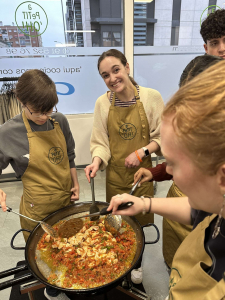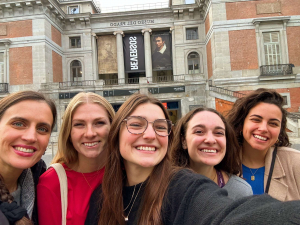La Universidad
Universidad, as you might guess, translates to university. Sounds fancy, right? A few times, I’ve made the mistake of calling it “college.” I didn’t realize that “el colegio,” which looks like college, doesn’t have the same significance that it does in the States. In general, “colegio” refers to any schooling. “Universidad” means a third-level education that comes after high school and is geared towards a specific degree.
I go to Universidad de Antonio de Nebrija in Madrid. I’m taking four classes in Spanish. The first one is “lengua espanola,” which literally means Spanish language. (No, they don’t capitalize it.) This is my only class on Tuesdays and Thursdays. We tend to focus on grammatical topics that aren’t necessarily verb tenses, concepts like “ser vs estar” and “por vs para.” In another class, specific grammar problems, so far, we’ve been focusing on verb tenses. After a quick review of the imperative (commands), we’ve spent a lot of time forming the past tense. It doesn’t seem like it would be difficult, but when there are four different tenses to speak about the past, sometimes it can be a bit confusing. This is my first class on Mondays and Wednesdays. Right after, I have “panorama de la literatura espanola.” Most of these words are cognates: panorama of Spanish literature. I expected this class to be the most difficult for me. I expected to have to read entire novels and interpret complex poems. So far, this is one of my favorite classes. Our teacher does a fantastic job of explaining the historical context of a few literature works. Then we read a part, and she explains the rest of it. My last class is “Arte en el Museo Prado”. We focus on three specific artists and learn about the eras in which they painted. We get to talk about and critique art and even go to the Prado Museum three times.
Each week, we have three hours of each class, which is equal to 12 credits in the US. This is the least amount of college classes/credits I’ve taken. I have so much free time that I sometimes don’t know what to do. I have time to journal and watch Netflix! My latest class goes until 1:30, while some students don’t finish their school days until 7:30 at night. I have the entire afternoon and evening to do homework and explore the city. Not only am I taking fewer classes, but the homework load is a lot lighter. Some classes, like lengua espanola and grammar problems, assign homework every class period. Luckily, this homework takes maybe half an hour, depending on the topic and number of activities.
After classes, finding things to do that feel productive but require spending money can be challenging. Occasionally, we go to a cafe to have a different atmosphere while we journal or do homework. On other days, if the weather is nice, we walk around to nearby “barrios” or neighborhoods. Sometimes we walk to the shopping street and browse stores (and buy clothes). The best part about the schedule is that we only have classes four days a week, and on Thursdays, we end at 10:30. Because of this, we can make travel plans, even to visit other countries. Recently, we went to Portugal for the weekend and could take the cheaper bus option because of the time we had on Thursday. I’m planning a few more weekend trips in the future, too.
So far, I’m loving so much about Madrid, and I’m excited to be here another three months!



